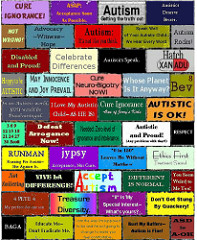For the first time in months and months — far longer than it should have been, but there we are with the insane busyness of life — a friend and I got together at her house for dinner.
“You look like you’re finally relaxing,” she said after I’d been there a little while, and we decided to not wait in conversational limbo for the third person (who never did show). “You were so stiff when you came in,” and she made reference by some expression (that now escapes memory) of how I was indicating being relaxed by behaving more normally.
Not “normally” in the er, Normal (neurotypical) sense, but me-normal, where I felt comfortable enough to sit and rock slightly, to not worry about making eye contact, to get a bit flappy at funny events or when agitated, to shed the pent-up motor tics. To just be me. To “let my hair down” and to set aside unnecessarily restrictive social norms. To eat my chicken and rice with a fork, and the still-crisp cooked green beans neatly with my fingers (as one does with fries or asparagus), because her table was Nicely Set for our aesthetic enjoyment and yet we weren’t standing on formality.
We talked about typical stuff, like the foibles of spouses, the concerns for college-age kids, the drudgery of eternal home repairs, the quirks of cats, of temperamental computers and the thrills of new mobile phones, of career changes, and the vicissitudes of economic times.
We also talked about atypical stuff, like the difficulties of college education and employment when dealing with various educational/neurological disabilities, of managing arthritis pain and joint issues, of the wonders of TMJ bite blocks, of dealing with the profound cluelessness of the general public for the extreme pain of migraines and how hospital Emergency (A&E) is a horrid place to physically be when in the throes of gut-wrenching-head-splitting pain and the snarkiness of some medics therein.
Crip chicks like we don’t diss on our disabilities, we diss from our disabilities. It’s not poor-pitiful-me whining but the healthy pitch-a-bitch whining from someone who understands, even when our respective glitches are not all issues shared in common.
I need more social life, but there’s so much of ordinary socialising that I find enervating.
I’m not antisocial; the interest in socialising is not a binary form, where one either does it or doesn’t do it. But over the years I have learned what I actually enjoy (as opposed to what one is “supposed to” enjoy). My intro/extroversion levels vary wildly because some kinds of social interaction are nothing but draining, while others leave me (if not physically) at least spiritually recharged.
I’m not fond of socialising by large quantities of people all chattering with each other in the same room, where the conversations get all blenderized from my Auditory Processing Disorder, to where I end up trying to tease apart sequential fragments of half a dozen unrelated conversations, fruitlessly trying to follow just one voice or two, and reasoning out from fractured context what some of the mis-heard words could possibly be.
I’m not fond of socialising where the content gets watered down to less-consequential subjects of chit-chat, by dint of less privacy and some unwritten code of how long one is “supposed” to entertain time with another guest before moving on, and by the other unwritten rules of conversational quid pro quo, where my monologuing to fully deliver a story complete with back-explanations and thesis statements delivered at the end is discouraged in favor of witty repartee.
I like the time to mutually share and analyse our respective news, and the real, content-laden answers to our mutual questions of, “How are you?” The real “How are you?” question, not the fluff of “How-are-you?” or “How-was-your-day?” that is the social minefield trying to distinguish between polite interested query of acquaintances and polite disinterested query of associates (that latter social coin that is all form and no content), or the mental quagmire of trying to answer “How-was-your-day?” when the question is so vague and our answers are so experientially linear and tangential instead of whatever the hell others were expecting.
I was comfortable — we both were comfortable — because together we had created a social environment that enabled our mutual comfort. It was an agreement that had been developed by long familiarity and by various conscious decisions over decades, to create a friendship that fulfilled our individual needs over the culturally-proscribed forms. True friendship enables positive interactions, and supports needs and affirms and enriches our lives.
Here’s a toast to real friendships!







